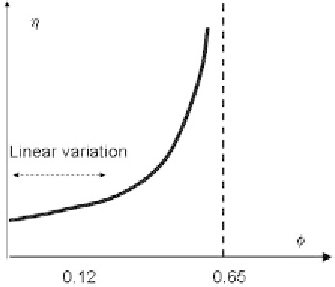Biomedical Engineering Reference
In-Depth Information
Figure 6.9
Relation between specific viscosity and volume fraction.
In (6.21) the constant
k
is called the Huggins's constant. Relation (6.21) is rep-
resented in Figure 6.10.
A rapid and approximate calculation shows that for many applications in bio-
technology—such as the transport of DNA—the volume fraction of target mac-
romolecules or nanoparticles is small. Suppose a concentration of substance
c
0
is
expressed in M (mole/liters). Its value in mole per cubic meters is 10
3
c
0
. If we note
R
H
,
the hydraulic radius of a single element of the substance, then the volume of this
element is
V
= 4/3
pR
H
3
and the volume fraction of the substance is
3
ϕ
=
10
c A V
(6.22)
0
DNA
where
A
is the Avogadro number (
A
= 6.02 10
23
). Typically for DNA analysis, the
maximum concentration is 1
m
M, and by taking an approximate hydraulic radius
of
R
H
= 20 nm = 20 10
-9
m, relation (6.22) gives the maximum volume fraction of
f
= 0.02. The value of the specific viscosity is then only 5%.
However, there is an exception. With the development of cellular microfluid-
ics, polymeric solutions are increasingly used, and the viscosity of the solution is
Figure 6.10
Apparent viscosity versus volume fraction of particles.





